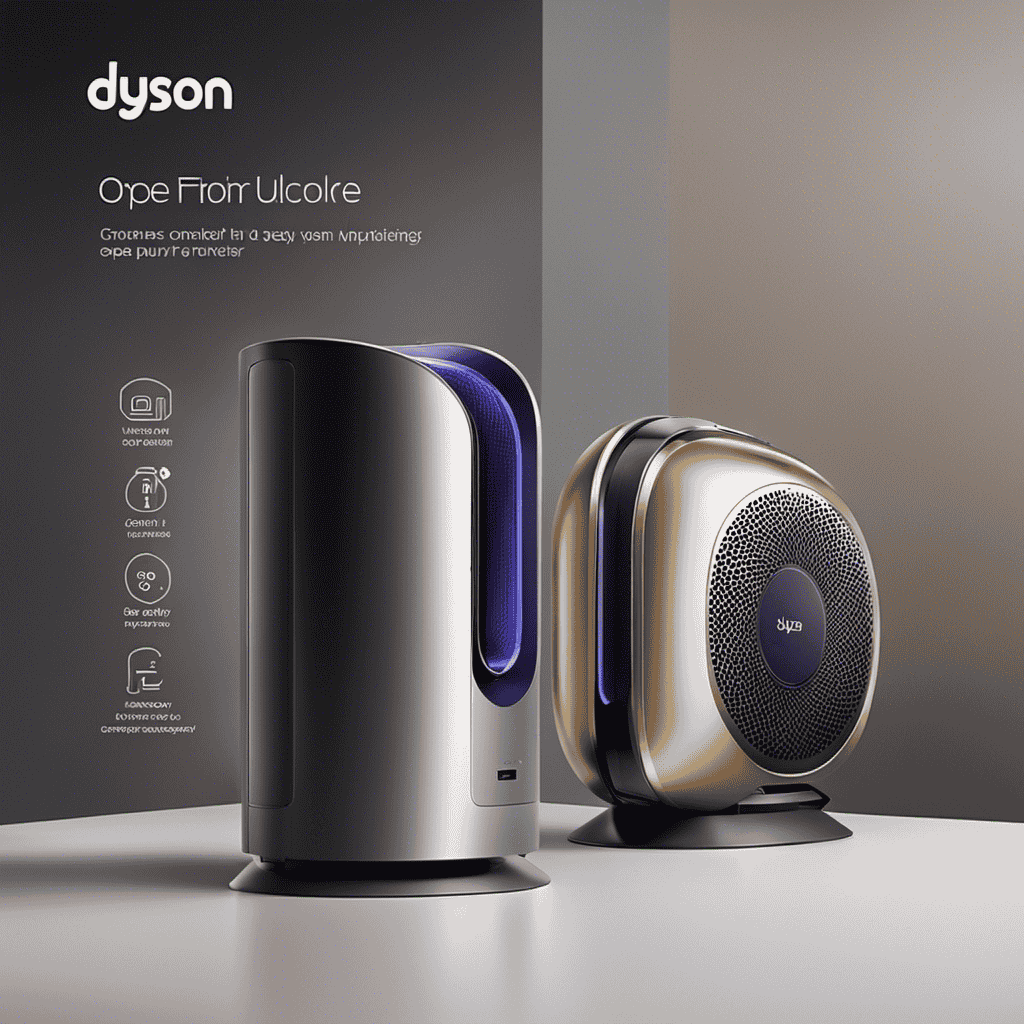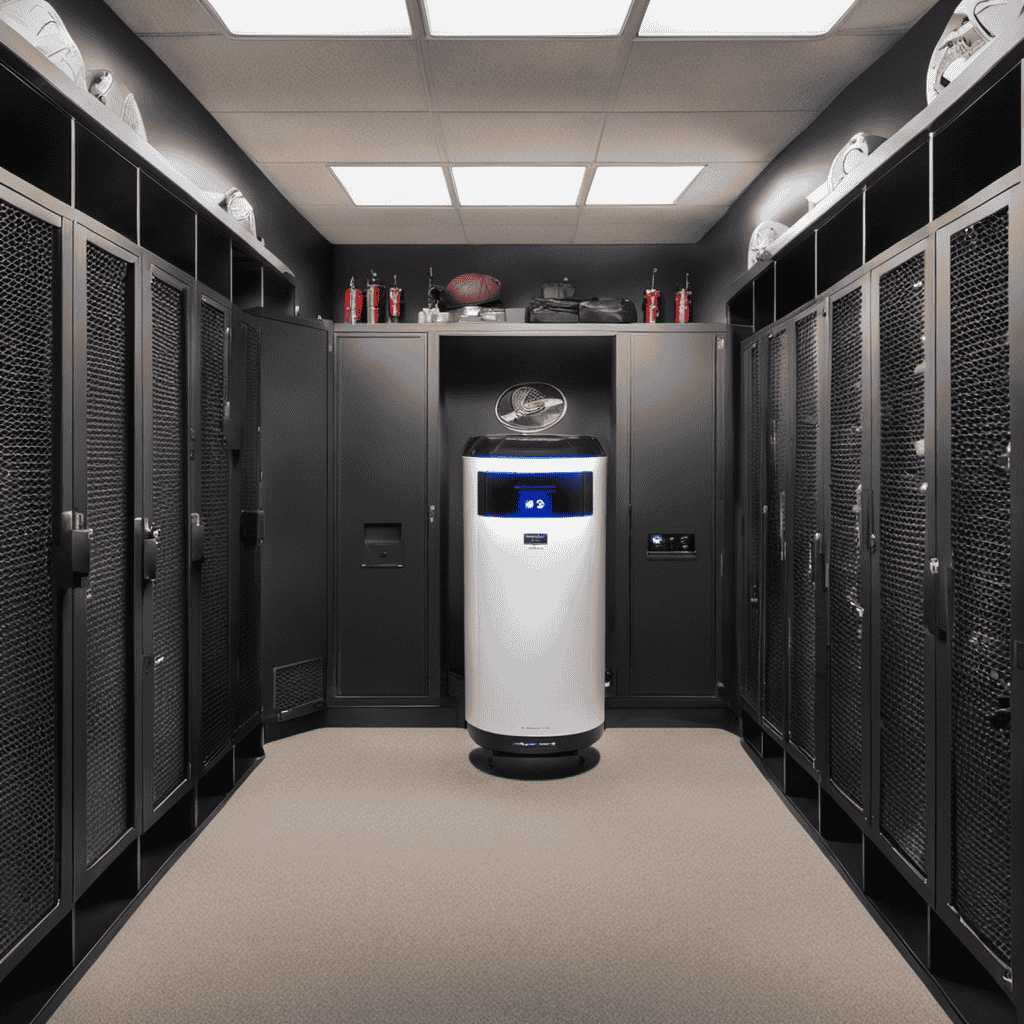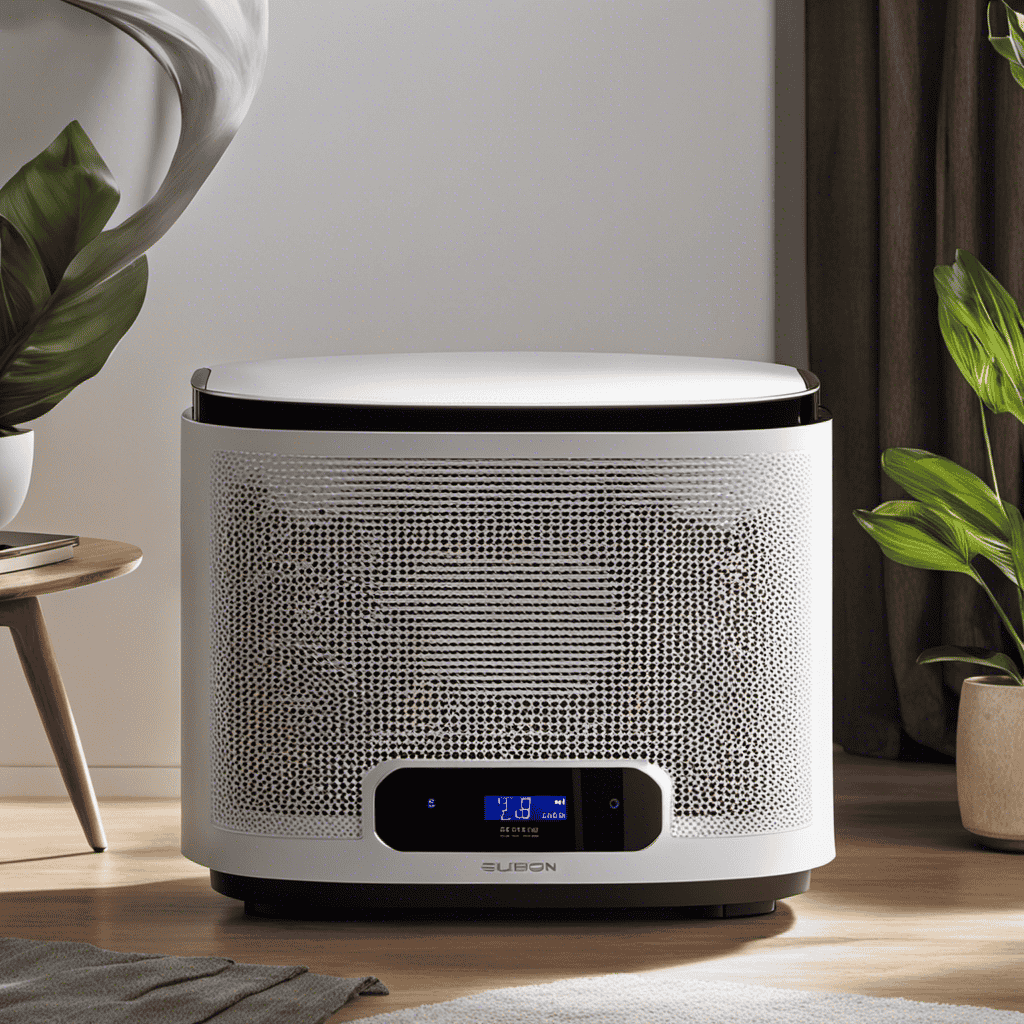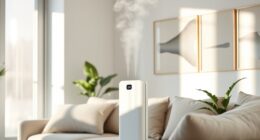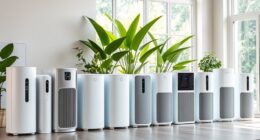As a fan of air quality, I recognize the significance of inhaling pure, crisp air.
So, let’s dive into the world of air purifiers together and discover the best way to buy one.
With so many options out there, it can be overwhelming. But fear not! In this article, I will guide you through the process, step by step, like a trusted friend holding your hand.
Together, we’ll determine your needs, explore different types, and ultimately make an informed decision.
Let’s get started!
Key Takeaways
- Conduct air quality testing to identify specific pollutants and their concentration levels before purchasing an air purifier.
- Evaluate the square footage of the room and choose an air purifier that matches the size of the space.
- Compare filtration systems based on their efficiency, Clean Air Delivery Rate (CADR), and filter lifespan.
- Consider factors such as noise levels, energy efficiency, and user-friendly features when selecting an air purifier.
Determine Your Air Quality Needs
First, you’ll need to figure out your specific air quality requirements. Determining the level of air purifier effectiveness you require involves conducting air quality testing. This will help you identify the specific pollutants present in your environment and the concentration levels.
By conducting air quality testing, you can gather evidence-based data to make an informed decision about the type of air purifier you need. There are various methods to test air quality, such as using air monitoring devices or hiring professional services. These tests measure parameters like particulate matter (PM), volatile organic compounds (VOCs), carbon dioxide (CO2), and other harmful substances.
Understanding your air quality needs will ensure that you choose an air purifier that effectively removes the specific pollutants present in your environment.
Understand Different Types of Air Purifiers
To better understand the different types of air purifiers, you should start by researching the various features and technologies available. When it comes to air purifiers, there are numerous brands and technologies to choose from. It’s important to understand the different options in order to make an informed decision. Here is a table outlining some popular air purifier technologies used by different brands:
| Technology | Brand |
|---|---|
| High-Efficiency | Dyson |
| Particulate Matter | Coway |
| Activated Carbon | Blueair |
These are just a few examples, and each brand may offer different technologies. By researching the different brands and their air purifier technology, you can determine which one best suits your needs. Now that you understand the different types of air purifiers, let’s move on to the next step: considering the size of your space.
Consider the Size of Your Space
Now that you know the different types of air purifiers available, it’s important to consider the size of your space. Choosing the right size air purifier is crucial for its effectiveness in cleaning the air in your home or office. Here are three key factors to consider:
-
Room Size: Measure the square footage of the room where you plan to place the air purifier. Different air purifier brands have different coverage capacities, so make sure to choose one that matches the size of your space.
-
Air Changes per Hour (ACH): ACH refers to the number of times the air in a room is cleaned and replaced by the air purifier in one hour. A higher ACH is recommended for larger spaces or areas with higher levels of pollution.
-
Ceiling Height: If you have high ceilings, it’s important to choose an air purifier that can effectively circulate and filter the air at higher levels.
Considering these factors will ensure that you select the right size air purifier for your specific needs. Remember to also follow proper air purifier maintenance guidelines to keep it functioning optimally and maintaining clean air quality in your space.
Evaluate the Filtration Technology
When it comes to choosing effective filters for air purification, there are a few key points to consider.
First, it’s important to evaluate the filtration technology used in different systems. HEPA filters are widely considered to be the most effective at removing airborne particles, while activated carbon filters are effective at trapping odors and chemicals.
Additionally, comparing filtration systems based on their Clean Air Delivery Rate (CADR) can help determine how quickly and efficiently they can clean the air in a given space.
Choosing Effective Filters
You should consider the different types of filters available to find one that effectively removes pollutants from the air. When evaluating the performance of air purifier filters, it is important to compare their effectiveness in capturing various types of pollutants.
Here are three factors to consider:
-
Particle size: Look for filters that can capture particles as small as 0.3 microns, as these are the most harmful to your health.
-
Filter lifespan: Consider the lifespan of the filter and how often it needs to be replaced. Some filters may require frequent replacement, adding to the maintenance cost.
-
Additional filtration stages: Filters with multiple stages, such as activated carbon or UV light, can provide additional protection against gases, odors, and bacteria.
By carefully evaluating these factors, you can choose a filter that offers optimal performance and effectively removes pollutants from the air.
Now, let’s move on to comparing filtration systems.
Comparing Filtration Systems
To compare filtration systems, take into account the different features and technologies they offer. One important factor to consider is the filtration efficiency of the system. This refers to how effectively the purifier can remove pollutants from the air. Different brands may use different technologies to achieve high filtration efficiency. For example, Brand A may use a HEPA filter, while Brand B may use an activated carbon filter. It is important to research and compare the filtration efficiency of different air purifier brands to ensure you are getting the best system for your needs. Below is a table comparing three popular brands:
| Brand | Filtration Technology | Filtration Efficiency |
|---|---|---|
| Brand A | HEPA | 99.97% |
| Brand B | Activated Carbon | 95% |
| Brand C | Electrostatic | 98% |
Compare Noise Levels
If noise levels are a concern for you, compare the decibel ratings of different air purifiers before making a purchase. The noise level of an air purifier can greatly impact your comfort, especially if you plan on using it in your bedroom or office.
Here are three important factors to consider when comparing noise levels:
-
Decibel (dB) ratings: Look for air purifiers with low dB ratings, preferably below 50 dB. This ensures a quiet operation without disturbing your sleep or work.
-
Sound level analysis: Some air purifiers feature multiple fan speeds, and the noise level can vary depending on the speed setting. Check if the dB rating changes at different speeds to find the most suitable option for your needs.
-
User reviews: Reading reviews from other customers can provide valuable insights into the actual noise level of an air purifier. Look for reviews that specifically mention the noise level and compare the experiences shared by different users.
By considering these factors, you can find an air purifier that not only effectively cleans the air but also operates at a noise level that suits your preferences.
Now let’s move on to the next section, where we will assess the energy efficiency of air purifiers.
Assess Energy Efficiency
When it comes to choosing an air purifier, there are several key points to consider when assessing energy efficiency.
First, look for energy-saving air purifiers that are designed to consume less power while still maintaining effective performance. These models not only help reduce energy consumption, but also save on electricity costs in the long run.
Additionally, it’s important to pay attention to energy efficiency ratings, such as the Energy Star certification, which indicates the product’s energy-saving capabilities and overall environmental impact.
Energy-Saving Air Purifiers
Energy-saving air purifiers can help reduce electricity consumption while effectively cleaning the air in your home. These devices utilize energy-saving technology to minimize their environmental impact. Here are three key reasons why energy-saving air purifiers are a smart choice:
-
Lower energy consumption: Energy-saving air purifiers use less electricity compared to traditional models. This leads to lower energy bills and reduced carbon emissions, contributing to a greener and more sustainable environment.
-
Extended lifespan: Energy-saving air purifiers are built with durable components and advanced technologies that help prolong their lifespan. This means fewer replacements and less waste generated, further reducing the overall environmental impact.
-
Energy-efficient features: These air purifiers often come with energy-saving features such as programmable timers, auto-shutoff functions, and sleep modes. These features allow you to customize and optimize the device’s energy usage based on your specific needs, resulting in additional energy savings.
Cost-Effective Power Consumption
Using energy-efficient appliances can save you money on your electricity bills in the long run. When it comes to air purifiers, there are cost-effective filters and energy-saving options available that can help you reduce your power consumption.
Cost-effective filters, such as HEPA filters, efficiently capture particles as small as 0.3 microns, ensuring clean and fresh air in your home while minimizing energy usage. Additionally, some air purifiers come with energy-saving features like programmable timers and sleep modes, allowing you to customize their operation and optimize energy efficiency.
By choosing air purifiers with cost-effective filters and energy-saving options, you not only save money on your electricity bills but also contribute to a greener environment.
Now, let’s explore another important aspect of air purifiers – their energy efficiency ratings.
Energy Efficiency Ratings
There’s a simple way to determine the energy efficiency of appliances – just look for the Energy Star label. This label is a symbol of energy saving technology, indicating that the appliance has met strict guidelines set by the Environmental Protection Agency (EPA).
When you choose an appliance with the Energy Star label, you can expect the following benefits:
-
Lower energy bills: Energy efficient appliances use less electricity, which translates to savings on your monthly utility bills. This not only saves you money but also reduces the strain on the environment by decreasing the demand for energy.
-
Reduced environmental impact: By choosing energy efficient appliances, you are actively contributing to the reduction of greenhouse gas emissions. Energy efficient appliances consume less electricity, resulting in a lower carbon footprint and a healthier planet.
-
Longer lifespan: Energy efficient appliances are often built with higher quality components, leading to a longer lifespan and fewer repairs. This not only saves you money in the long run but also reduces waste by minimizing the need for disposal and replacement.
Look for User-Friendly Features
When purchasing an air purifier, it’s important to consider user-friendly features.
The advancements in air purifier technology have made it easier than ever to improve indoor air quality.
One of the key features to look for is user-friendly controls. These controls allow you to easily adjust settings and customize the purifier to your specific needs.
Look for air purifiers with intuitive touchscreens or remote controls that make it effortless to navigate through different modes and settings.
Some models even come with smart features, such as Wi-Fi connectivity, allowing you to control the purifier using your smartphone.
Additionally, consider air purifiers that have filter replacement indicators, so you know exactly when it’s time to change the filters.
Consider Maintenance Requirements
It’s essential to factor in maintenance requirements when considering an air purifier. Neglecting maintenance can lead to increased costs and decreased performance over time. Here are three important aspects to consider:
-
Filter Replacement: Air purifiers typically have filters that need to be replaced regularly. Look for models with easily accessible and affordable replacement filters to keep maintenance costs in check.
-
Cleaning Frequency: Some air purifiers require regular cleaning to remove dust and other particles that accumulate on the surfaces. Consider how often you’re willing to clean the unit and choose a model that suits your maintenance preferences.
-
Long-Term Durability: Investing in an air purifier with a reputation for long-term durability can save you money in the long run. Look for models with high-quality construction and positive customer reviews to ensure your purchase lasts for years to come.
Check for Certifications and Ratings
When purchasing an air purifier, it’s crucial to look for trusted certification labels and consider the importance of ratings.
Trusted certification labels, such as Energy Star and AHAM Verified, guarantee that the product meets specific standards and performance criteria.
Ratings, such as CADR and MERV, provide valuable information about the air purifier’s effectiveness in removing pollutants and improving indoor air quality.
Trusted Certification Labels
A trusted certification label ensures that the air purifier meets certain quality and safety standards. When it comes to purchasing an air purifier, it is crucial to look for these trusted certification labels. Here are three reasons why third party verification is of utmost importance:
-
Peace of mind: With a trusted certification label, you can be confident that the air purifier has been independently tested and verified to meet specific standards. This provides assurance that the product is reliable and performs as advertised.
-
Health and safety: Air purifiers are designed to improve indoor air quality, and trusted certification labels ensure that the device is effective at removing pollutants and allergens. This is especially important for individuals with respiratory issues or allergies.
-
Energy efficiency: Certification labels also verify the energy efficiency of the air purifier. By choosing a certified product, you can be sure that it meets energy-saving standards, helping you save on electricity bills while reducing your carbon footprint.
Importance of Ratings
One important factor to consider is the overall rating of the certified air purifier. When looking to purchase an air purifier, it is crucial to examine its rating to ensure that it meets your specific needs.
Ratings provide valuable information about the effectiveness of the air purifier in removing contaminants from the air. A higher rating indicates a more efficient and powerful air purifier.
Additionally, ratings can also provide insight into the energy-saving benefits of the device. Energy-efficient air purifiers not only help in reducing electricity consumption but also contribute to cost savings in the long run.
Set a Budget
To set a budget for buying an air purifier, you should first determine how much you can afford to spend. Consider the following cost considerations when deciding on your budget:
-
Quality vs. Price: It’s important to find a balance between the cost of the air purifier and its quality. While you may be tempted to go for a cheaper option, keep in mind that a higher quality air purifier will be more effective in removing pollutants from the air.
-
Long-term Savings: Investing in a more expensive air purifier upfront may save you money in the long run. Higher quality purifiers often have better filters that last longer, reducing the need for frequent replacements.
-
Additional Features: Some air purifiers come with extra features such as sensors, timers, or remote controls. While these features may increase the cost, they can enhance the convenience and efficiency of the purifier.
Considering these factors will help you determine the appropriate budget for your air purifier purchase. Once you have established your budget, it’s time to research reputable brands and models that fit within that range.
Research Reputable Brands
When researching reputable brands, make sure to read customer reviews and compare different models to find the best option for you. With the advancements in air purifier technology, there are now more cost-effective options available on the market. These new models offer improved filtration systems, longer lifespan, and energy efficiency. To help you in your search for the right air purifier, I have compiled a table comparing three top brands:
| Brand | Model | Features |
|---|---|---|
| Brand A | Model X | HEPA filtration, smart sensor technology, low noise |
| Brand B | Model Y | Activated carbon filter, ionizer, remote control |
| Brand C | Model Z | UV-C light technology, ozone-free, filter replacement indicator |
Read Customer Reviews and Ratings
After researching reputable brands, the next step in buying an air purifier is to read customer reviews and ratings. This is an important step because it allows me to gain insights from real users and understand their experiences with different models.
To ensure the accuracy of the information, I rely on trusted review sources such as Consumer Reports, Amazon, and Best Buy. These platforms provide a wealth of customer feedback and ratings that can help me make an informed decision.
By reading customer reviews, I can also identify common complaints that users have about certain air purifiers. This helps me avoid potential issues and choose a model that addresses my specific needs. It’s crucial to consider both positive and negative reviews to get a comprehensive understanding of a product’s performance.
Markdown list:
- Frustration: Customers express frustration when the air purifier fails to effectively remove odors.
- Noise: Some customers complain about excessive noise levels, which can be disruptive in their homes or workplaces.
- Durability: A common complaint is the short lifespan of air purifiers, with customers reporting breakdowns or malfunctions within a few months of purchase.
Compare Prices and Options
When it comes to purchasing an air purifier, two key factors to consider are the cost versus the features. It’s important to assess whether the price of the air purifier aligns with the features it offers and if it meets your specific needs.
In addition, researching customer reviews can provide valuable insights into the performance and reliability of different air purifiers.
Cost Vs. Features
The cost of an air purifier often determines the features it offers. When considering the cost, it’s important to weigh the long-term savings that certain features can provide. Here are three cost-effective features to consider:
-
HEPA filtration: A high-efficiency particulate air (HEPA) filter is a must-have feature. It can remove up to 99.97% of airborne particles, including dust, pollen, and pet dander. This not only improves the air quality in your home but also reduces the need for frequent cleaning and maintenance.
-
Energy efficiency: Look for an air purifier with an Energy Star certification. These models are designed to consume less energy, resulting in lower electricity bills. Over time, this can lead to significant long-term savings.
-
Filter replacement indicators: Opt for an air purifier that has a filter replacement indicator. This feature will remind you when it’s time to replace the filters, ensuring optimal performance and preventing unnecessary expenses.
Research Customer Reviews
After considering the cost and features of different air purifiers, the next step in my buying process is to research customer reviews.
This is an important step because it allows me to compare brands and gauge customer satisfaction with each product. By reading reviews from actual users, I can get a better understanding of the air purifier’s performance, durability, and overall effectiveness.
I pay close attention to reviews that highlight specific features that are important to me, such as noise level, filter lifespan, and ease of use. Positive reviews with high ratings and detailed explanations give me confidence in the product’s quality. On the other hand, negative reviews that consistently mention the same issues could be a red flag.
Transitioning into the next section, considering additional features and accessories will help me make a well-informed decision.
Consider Additional Features and Accessories
You should also check if the air purifier has any additional features or accessories. These can enhance the functionality and convenience of the device. Here are three important features and accessories to consider:
-
Timer function: This allows you to set specific time intervals for the air purifier to operate. It can help you save energy and ensure the purifier is running when you need it the most.
-
Filter replacement indicator: This feature alerts you when it’s time to replace the filters. It ensures that the purifier continues to provide optimal air quality and prevents the buildup of pollutants.
-
Remote control: Having a remote control allows you to conveniently adjust the settings of the air purifier from anywhere in the room. It eliminates the need to physically reach the device and provides added convenience.
Make an Informed Decision and Purchase
By considering these features and accessories, you can make an informed decision and purchase the perfect air purifier for your needs.
When it comes to air purifier effectiveness, it’s important to understand that not all models are created equal. Some purifiers use HEPA filters, which are highly effective at removing particles as small as 0.3 microns from the air. These filters can capture dust, pollen, pet dander, and even some bacteria and viruses. Additionally, look for purifiers with activated carbon filters, as they can help remove odors and volatile organic compounds (VOCs) from the air.
The benefits of having an air purifier are numerous. They can improve indoor air quality, reduce allergy and asthma symptoms, and create a cleaner and healthier living environment.
Frequently Asked Questions
Can I Use an Air Purifier in My Car?
Yes, you can use a car air purifier. It offers numerous benefits, such as removing allergens, pollutants, and odors from the air inside your car. It helps improve air quality and create a healthier environment.
How Often Should I Replace the Filters in My Air Purifier?
To keep my air purifier working efficiently, I replace the filters every 3-6 months. Regular cleaning ensures it removes pollutants effectively, promoting better indoor air quality and reducing allergies.
Are There Any Potential Health Risks Associated With Using an Air Purifier?
There are potential side effects and long term effects associated with using an air purifier. It is important to consider factors such as ozone emissions, filter efficiency, and maintenance requirements when purchasing one.
Can an Air Purifier Remove Pet Dander and Allergens From the Air?
Yes, an air purifier can remove pet dander and allergens from the air. As a pet owner, I have experienced the benefits of using an air purifier for allergies. It helps improve air quality and reduces allergic reactions.
Can an Air Purifier Help With Odors and Chemical Fumes in the Air?
Yes, an air purifier can help with odors and chemical fumes in the air. Regular air purifier maintenance is important for optimal performance. The benefits of using an air purifier include improved air quality and reduced exposure to harmful pollutants.
Conclusion
After conducting thorough research and analysis, I’ve successfully navigated the complex world of air purifiers.
By considering factors such as air quality needs, size of space, filtration technology, noise levels, customer reviews, and prices, I’ve gained a comprehensive understanding of the options available.
Armed with this knowledge, I can confidently make an informed decision and purchase the air purifier that best suits my needs.
Like a skilled detective solving a mystery, I’ve unraveled the secrets of air purification and I’m ready to breathe in clean, fresh air.

